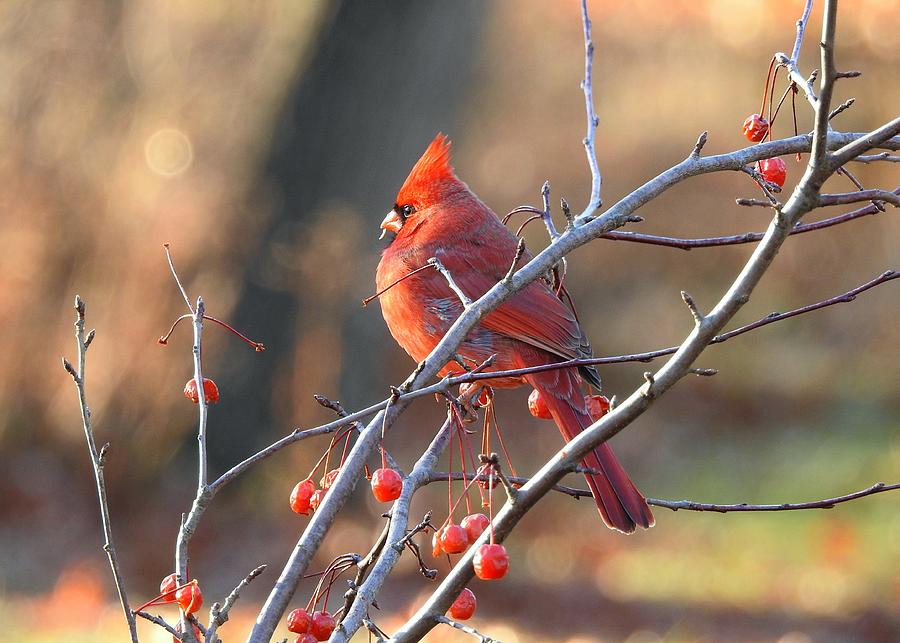Parrots are a beloved bird group known for their vibrant colors, charisma, and intellect. Unfortunately, nearly one-third of all parrot species face extinction, and several of these cherished parrots have already become extinct. The Earth was more vibrant when flocks of different parrots flew across the sky like daylight fireworks, flashing orange, yellow, and green.
According to, there are 16 extinct types of parrot species that we know of. This article will discuss these 16 extinct parrot species and other interesting facts about them. Parrots are among the smartest bird species, and their ability to mimic human speech makes them a particularly popular choice for pets.
You are reading: Discover 16 Extinct Types Of Parrot
However, no amount of intelligence can outwit extinction, and a few of their species have already vanished. The IUCN Red List of species comprises four percent extinct parrot species, and the rate of extinction seems to be increasing.
In this article, we will explore the 16 extinct types of parrot species and learn more about these fascinating birds.

16 Extinct Types Of Parrot
Carolina Parakeet
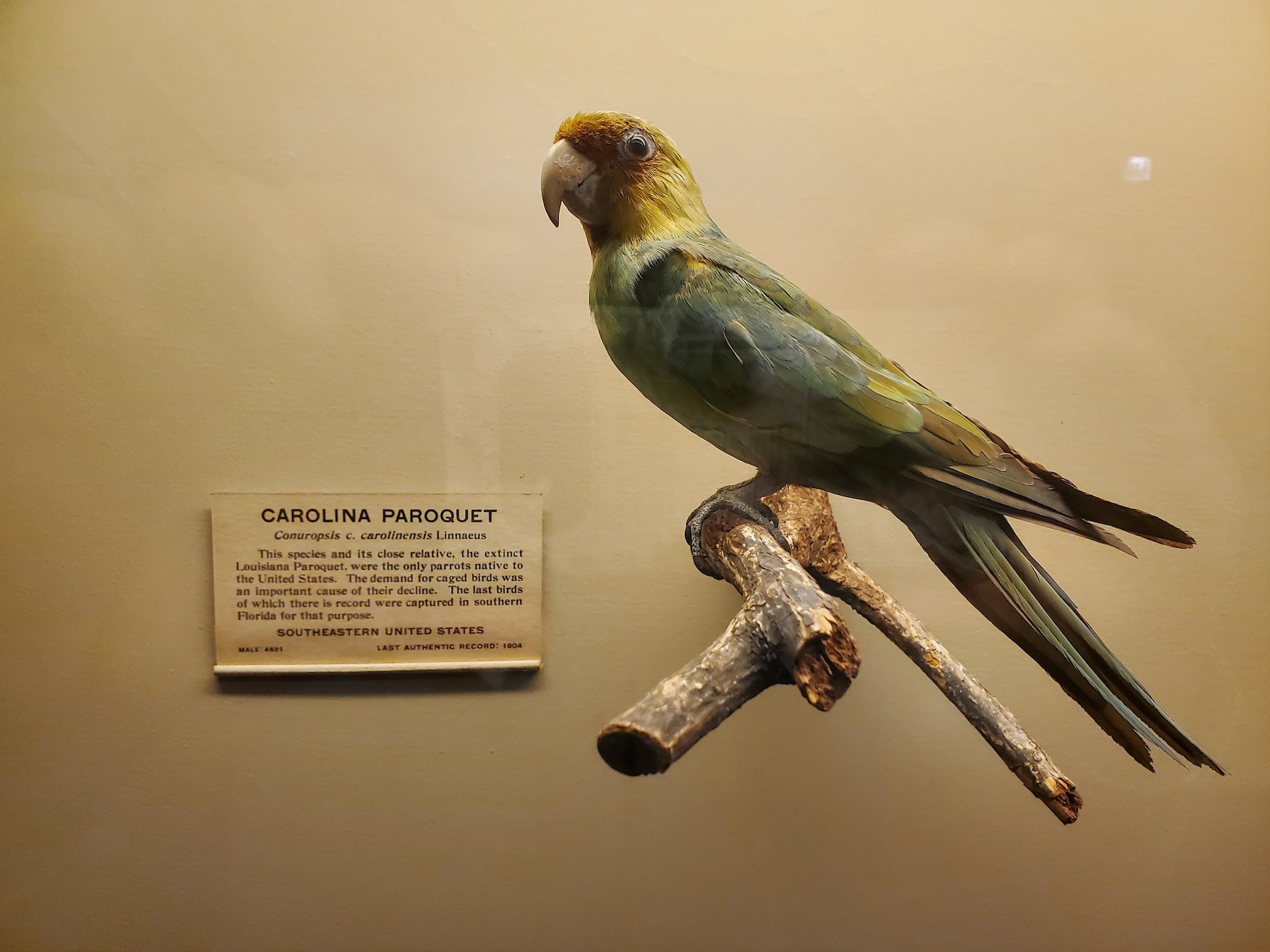
The Carolina parakeet (Conuropsis carolinensis), also known as the Carolina conure, was a small green neotropical parrot with a bright yellow head, reddish-orange face, and pale beak that was native to the Eastern, Midwest, and Plains states of the United States. It was the only indigenous parrot within its range, as well as one of only three parrot species native to the United States.
The Carolina parakeet was a brilliantly colored, medium-sized parrot that traveled in large, noisy flocks of around 300. It typically lived in old, swampy forests and was once widespread across eastern North America, from the Gulf of Mexico all the way to southern Ontario.
Unfortunately, the Carolina parakeet was declared extinct in 1939. The last known wild specimen was killed in Okeechobee County, Florida, in 1904, and the last captive bird died at the Cincinnati Zoo on February 21, 1918.
The Carolina parakeet is believed to have died out because of a number of different threats, including deforestation, disease, persecution by farmers, and competition from honeybees.
Norfolk Kākā
The Norfolk kākā (Nestor productus) was a large species of parrot that was native to Norfolk Island and adjacent Phillip Island. It was a relative of the New Zealand kākā.
The Norfolk kākā was about 38 cm long, with mostly olive-brown upperparts, reddish-orange cheeks and throat, straw-colored breast, thighs, rump, and lower abdomen dark orange, and a prominent beak.
The species likely became extinct in the late 18th or early 19th century due to habitat loss and hunting by humans. The last confirmed sighting of the Norfolk kākā was in 1851.
Little is known about the species, but it was thought to have been a bird of the forest, and it was believed to have fed on flowers and blossoms of native trees found on Norfolk Island and nearby islands.
The vocalizations of the Norfolk kākā have been described as sounding like a dog barking, and they also made harsh “quacking” sounds. The Norfolk kākā is now extinct, and the last known specimen is held at the Naturalis Biodiversity Center in the Netherlands.
Paradise Parrot
The Paradise parrot (Psephotellus pulcherrimus) was a medium-sized, colorful parrot native to the grassy woodlands extending across the Queensland and New South Wales border area of eastern Australia. Once moderately common within its fairly restricted range, the last live bird was seen in 1927.
Extensive and sustained searches in the years since then have failed to produce any reliable evidence of it, and it is the only Australian parrot recorded as disappearing and presumed extinct.
The description of the species was first published by John Gould in 1845. The reasons for the sudden decline of the paradise parrot remain speculative, but possibilities include overgrazing, land clearing, changed fire regimes, hunting by bird collectors, and predation by introduced mammals like cats and dogs.
The Paradise parrot was already on the verge of extinction by 1900 in its habitat on the Darling Downs in Queensland. The last confirmed sighting of the Paradise parrot was in 1927. The species was considered for captive breeding and releasing into natural habitat, but that was abandoned when rotten eggs were found in 1922.
The Paradise parrot’s habitat was not preserved, and it failed to meet the aesthetic standards demanded for contemporary national park declarations.
Today, the Paradise parrot has the lamentable status of being the only mainland Australian bird species listed by the International Union for the Conservation.
Oceanic Eclectus Parrot
The Oceanic eclectus parrot (Eclectus infectus) was an extinct parrot species that occurred on Tonga, Vanuatu, and possibly Fiji. Its only living relative is the eclectus parrot (Eclectus roratus), which has proportionally larger wings than the Oceanic eclectus parrot.
The Oceanic eclectus parrot became extinct on Tonga during the early settlement 3000 years ago, presumably due to human-caused factors. On Vava’u, it may have survived into historic times because among the drawings which were created in 1793 during Alessandro Malaspina’s Pacific expedition, there is one sketch which appears to portray an Oceanic eclectus parrot.
This recently-described parrot may have survived as recently as the late 18th century, but became extinct most likely as a result of over-hunting and predation. The Oceanic eclectus parrot is now extinct, and the last known specimen is held at the Naturalis Biodiversity Center in the Netherlands.
Broad-billed Parrot
The Broad-billed parrot (Lophopsittacus mauritianus) was a large extinct parrot species in the family Psittaculidae that was endemic to the Mascarene island of Mauritius.
The species was first referred to as the “Indian raven” in Dutch ships’ journals from 1598 onwards. The broad-billed parrot’s head was large in proportion to its body, and there was a distinct crest of feathers on the front of the head.
The bird had a very large beak, comparable in size to that of the hyacinth macaw, which would have enabled it to crack hard seeds. Its bones indicate that the species exhibited greater sexual dimorphism in overall size and head size than any living parrot.
Read more : Top 7 Most Colorful Birds In The World
The broad-billed parrot had a disproportionately large head and jaws, and the skull was flattened from top to bottom, unlike in other Mascarene parrots.
Ridges on the skull indicate that its distinct frontal crest of feathers was firmly attached, and that the bird, unlike cockatoos, could not raise or lower it. The width of the hind edge of the mandibular symphysis (where the two halves of the lower jaw connected) indicate that the jaws were comparatively broad.
The broad-billed parrot was recorded on the dry leeward side of Mauritius, which was the most accessible for people, and it was noted that birds were more abundant near the coast, which may indicate that the fauna of such areas was more diverse. It may have nested in tree cavities or rocks, like the Cuban amazon.
The species became extinct due to hunting pressure, and the last records date from 1673-1675, with the species absent in 1693.
Rodrigues Parrot
The Rodrigues parrot, also known as Leguat’s parrot (Necropsittacus rodricanus), was an extinct species of parrot that was endemic to the Mascarene island of Rodrigues.
The species is known from subfossil bones and from mentions in contemporary accounts. It is unclear to which other species it is most closely related, but it is classified as a member of the tribe Psittaculini, along with other Mascarene parrots.
The Rodrigues parrot was green, and had a proportionally large head and beak and a long tail. Its exact size is unknown, but it may have been around 50 cm (20 in) long. It was the largest parrot on Rodrigues, and it had the largest head of any Mascarene parrot. Its plumage was described as being of uniform green coloration.
The species was last reported in 1761 and presumably hunted to extinction soon after. By the time it was discovered, it frequented and nested on islets off southern Rodrigues, where introduced rats were absent, and fed on the seeds of the shrub Fernelia buxifolia.
Two additional species have been assigned to its genus (N. francicus and N. borbonicus), based on descriptions of parrots from the other Mascarene islands, but their identities and validity have been debated.
Mascarene Parrot
The Mascarene parrot, also known as the mascarin (Mascarinus mascarinus), was an extinct species of parrot that was endemic to the Mascarene island of Réunion in the western Indian Ocean.
The taxonomic relationships of this species have been subject to debate; it has historically been grouped with either the Psittaculini parrots or the vasa parrots, with the latest genetic study favoring the former group. The Mascarene parrot was first mentioned by the French traveler Sieur Dubois in his 1674 travelogue and only described a few times from life afterwards.
At least three live specimens were brought to France in the late 18th century and kept in captivity, two of which were described while alive. Today, two stuffed specimens exist.
The Mascarene parrot was 35 cm (14 in) in length, with a large red bill and moderately long, rounded tail feathers. It had a black velvet-like facial mask on the front part of the head, and there are several discrepancies in how the color of the body, wings, tail feathers, and the head have historically been described and depicted.
The species became extinct due to excessive hunting and deforestation, and the last records date from the 18th century. Of the eight or so parrot species endemic to the Mascarenes, only the echo parakeet (Psittacula echo) of Mauritius has survived.
Guadeloupe Parakeet
The Guadeloupe parakeet (Psittacara labati) is a hypothetical species of parrot that would have been endemic to Guadeloupe. The species was first described by Jean-Baptiste Labat, a French Dominican priest, in 1722.
Labat described a population of small parrots living on Guadeloupe, which he called “perroquets” (parrots). He wrote that they were about the size of a blackbird, entirely green, except for a few small red feathers on their head, and had a white bill. The Guadeloupe parakeet was later named Conurus labati, and is now called the Guadeloupe parakeet.
However, there are no specimens or remains of the extinct parrots, and their taxonomy may never be fully elucidated. The species is presumed to have gone extinct in the late 18th century, if it did indeed exist.
The Guadeloupe parakeet is often placed in the genus Aratinga, and its taxonomy is unclear, with the validity of this species sometimes questioned. The species is monotypic, and little is known about it.
The Guadeloupe parakeet was mainly green with red on the crown, and had a pale yellow bill. The thighs were green, and the legs and feet were grey. Juveniles of the species are unknown.
Raiatea Parakeet
The Raiatea parakeet, also known as the Society kakariki or brown-headed parakeet, was an extinct parakeet species of the genus Cyanoramphus that was endemic to Raiatea, the second largest island of the Society Islands. The species was probably a forest bird, as this was the native habitat on the island.
The Raiatea parakeet was described as having a chocolate brown head, paler on the neck, rump, and wings, with olive yellow breast, abdomen, and undertail coverts.
The lower back and tail coverts exhibited a rufous brown coloring, and the underwing coverts and outer webs to flight feathers were greyish blue. The mid-rectrices were olive brown, and the outer rectrices were grey. The species was not sexually dimorphic.
The Raiatea parakeet averaged 25 cm (9.75 to 10 inches) in length, and its irises were orange-red in adults and brown in juveniles. The species is now extinct, probably due to habitat clearance or the action of invasive species.
The last confirmed sighting of the Raiatea parakeet was in 1773, and the species is known only from subfossil remains. The specimens are held at the Natural History Museum in London and in the Naturhistorisches Museum, Vienna.
Cuban Macaw
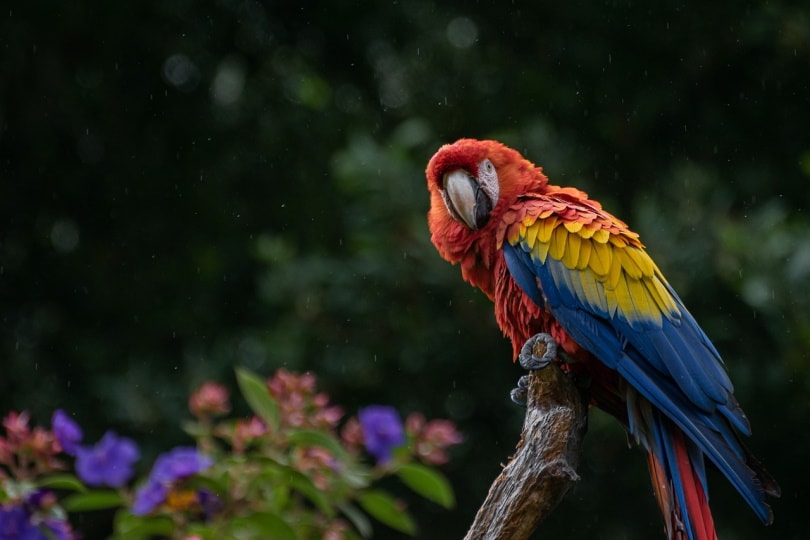
The Cuban macaw, also known as the Cuban red macaw, was an extinct species of macaw that was native to the main island of Cuba and the nearby Isla de la Juventud.
The species became extinct in the late 19th century, and little is known about its behavior. The Cuban macaw was one of the smallest macaws, measuring about 45-50 cm (18-20 in) long. It had a red, orange, yellow, and white head, and a red, orange, green, brown, and blue body.
The species’ original distribution on Cuba is unknown, but it may have been restricted to the central and western parts of the island. The Cuban macaw had a red forehead fading to orange and then to yellow at the nape of the neck, with white unfeathered areas around the eyes and yellow irises.
Read more : Do Penguins Have Legs Or Just Feet
The face, chin, chest, abdomen, and thighs were orange, and the upper back was brownish red with feathers scalloped with green. The rump, undertail feathers, and lower back were blue, and the wing feathers were brown, red, and purplish blue.
The Cuban macaw may have nested in hollow trees, lived in pairs or families, and fed on seeds and fruits. The species was reportedly becoming rare by the 1860s, and the last known specimen was collected in 1864.
Martinique Macaw
The Martinique macaw, also known as the orange-bellied macaw, is a hypothetical extinct species of macaw that may have been endemic to the Lesser Antillean island of Martinique in the eastern Caribbean Sea.
The species was scientifically named by Walter Rothschild in 1905, based on a 1630s description of “blue and orange-yellow” macaws by Jacques Bouton. No other evidence of its existence is known, but it may have been identified in contemporary artwork.
The Martinique macaw is one of 13 extinct macaw species that have been proposed to have lived in the Caribbean islands, but many of these species are now considered dubious because only three are known from physical remains, and there are no extant endemic macaws on the islands today.
The Martinique macaw was described as a new species of the macaw genus Anodorhynchus; A. martinicus. Other similar blue and yellow macaws, such as the “great macaw” (“Psittacus maximus cyanocroceus”), were also reported from Jamaica.
Birdlife International does not have an entry for the Martinique macaw, but it was mentioned in that of the Lesser Antillean macaw (which is considered Not Recognized) as possibly identical.
Saint Croix Macaw
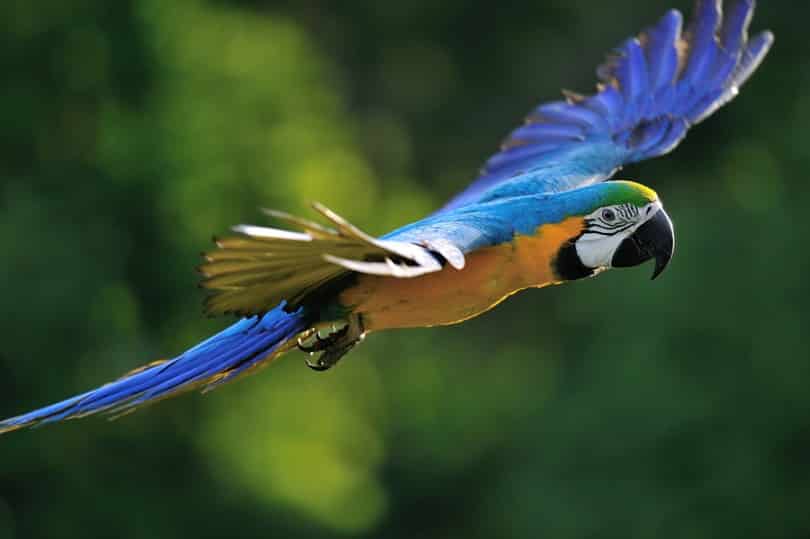
The St. Croix macaw, also known as the Puerto Rican macaw, was an extinct species of macaw that was native to the Caribbean islands of St. Croix and Puerto Rico.
The species was described in 1937 based on a tibiotarsus leg bone unearthed from a kitchen midden at a pre-Columbian site on St. Croix. A second specimen consisting of various bones from a similar site on Puerto Rico was described in 2008, while a coracoid from Montserrat may belong to this or another extinct species of macaw.
The St. Croix macaw is one of 13 extinct macaw species that have been proposed to have lived on the Caribbean islands. The species differed from other macaws in various skeletal details and shared several features with only the genus Ara.
Like other macaw species in the Caribbean, the St. Croix macaw is believed to have been driven to extinction by humans, as indicated by the fact that its remains were found in kitchen middens.
The last populations of the St. Croix macaw lived on the Caribbean islands of St. Croix and Puerto Rico, and the species is now extinct.
Newton’s Parakeet
Newton’s parakeet, also known as the Rodrigues parakeet or Rodrigues ring-necked parakeet, was an extinct species of parrot that was endemic to the Mascarene island of Rodrigues in the western Indian Ocean. Here are some key facts about Newton’s parakeet:
– Newton’s parakeet was around 40 cm (16 in) long, roughly the size of a rose-ringed parakeet.
– Its plumage was mostly greyish or slate blue in color, which is unusual in Psittacula, a genus containing mostly green species.
– The male had stronger colors than the female and possessed a reddish instead of black beak, but details of a mature male’s appearance are uncertain; only one male specimen is known, and it is believed to be immature.
– Subfossil remains of Newton’s parakeet show that it differed from other Mascarene Psittacula species in some osteological features, but also had similarities, such as a reduced sternum, which suggests a close relationship.
– Skeletal features indicate an especially close relationship with the Alexandrine parakeet and the rose-ringed parakeet (Psittacula krameri), but the many derived features of Newton’s parakeet indicates it had long been isolated on Rodrigues.
– Furthermore, Newton’s parakeet appeared to be ancestral to the parakeets of Mauritius and Réunion.
– The species is now extinct, and the last known specimen is held at the Natural History Museum in London and in the Naturhistorisches Museum, Vienna.
– The reasons for the extinction of Newton’s parakeet are not entirely clear, but it is believed to have been caused by habitat loss and hunting by humans.
New Caledonian Lorikeet
The New Caledonian lorikeet (Charmosyna diadema) is a potentially extinct species of lorikeet that is endemic to the Melanesian island of New Caledonia. Here are some key facts about the New Caledonian lorikeet:
Description:
– The New Caledonian lorikeet is 18-19 cm (7-7.5 in) long, with a slim and pointed tail that measures 7-8 cm (2.8-3.1 in).
– Its wings are slender and pointed, measuring 91 mm in the only specimen.
– The tarsus of the New Caledonian lorikeet is 16 cm (6.3 in) long.
– The plumage of the New Caledonian lorikeet is green, with a red forehead, blue crown, and a yellow collar around the neck.
Status:
– The New Caledonian lorikeet is considered potentially extinct, as it has not been reported since 1976.
– The species is known only from two females found before 1860, and unconfirmed sightings in the 1950s and 1976.
– The rarity of the species could be caused in part by its elusiveness, as lorikeets in this genus are notoriously difficult to detect, being unobtrusive and nomadic.
– Any remaining populations of the New Caledonian lorikeet are probably small and geographically fragmented, based on distance between sightings and remaining prime habitat.
Taxonomy:
– The New Caledonian lorikeet was formerly assigned to the genus Charmosyna, but was moved to the genus Vini based on a molecular phylogenetic study of the lorikeets published in 2020.
– The species was not sampled in the study, but was transferred to the newly-expanded Vini based on consideration of plumage and biogeography.
Conservation:
– The World Parrot Trust funded a project for the New Caledonian lorikeet in 2002, but the species has not been reported since 1976.
– Most authors hope that someone will yet rediscover the New Caledonian lorikeet, as it would be a very small, inconspicuous bird in a large, wild area that is difficult for ornithological field work.
Mariana Swiftlet
The Mariana swiftlet, also known as the Guam swiftlet, is a species of swiftlet in the family Apodidae. Here are some key facts about the Mariana swiftlet:
Description:
– The Mariana swiftlet is about 11 cm (4.3 in) in length with a dark grey-brown head and upperparts.
– Its throat and upper breast are grey-white with the rest of the underparts darker grey.
– The tail has a shallow fork and the plumage lacks gloss.
Distribution and habitat:
– The Mariana swiftlet is found in Guam as well as in Saipan and Aguiguan in the Northern Mariana Islands.
– The species is locally extinct on Rota and Tinian.
– It was also introduced successfully to Oahu in the Hawaiian Islands in the early 1960s, though the population there remains small.
– Its natural habitats are tropical moist lowland forest, mangrove forest, and grassland.
Behavior:
– The Mariana swiftlet is a tiny, all-dark swift that flies fast, fluttery, and batlike.
– It is usually observed flying continuously along ridges or over the forest canopy.
Conservation:
– The Mariana swiftlet is considered to be Endangered.
– The population on Guam declined because of predation by brown tree snakes and the use of agricultural pesticides, though it is believed to have subsequently increased to an estimated 900 individuals in 2006.
– The population on Saipan was estimated in 2005 to consist of about 5,400 individuals, though this population is at risk if the brown tree snake becomes established on the island.
– The estimated size of the Aguiguan population is about 400.
Oahu Oo
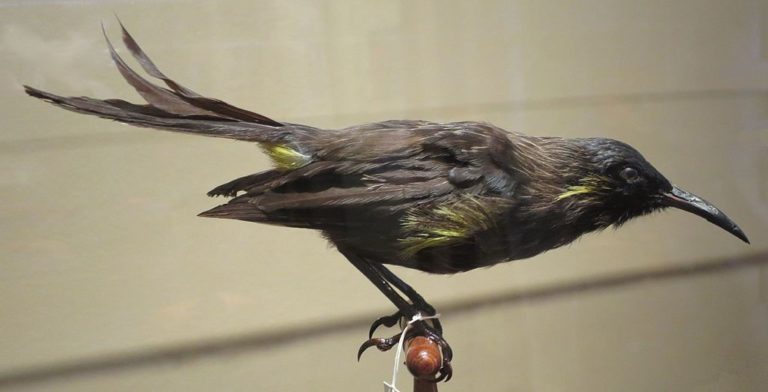
The Oahu Oo, also known as Moho apicalis, was a species of bird that was endemic to the Hawaiian island of Oahu. Here are some key facts about the Oahu Oo:
Description:
– The Oahu Oo was a medium-sized bird with a black plumage and yellow sides, flanks, and vent.
– It had a relatively slender, sharp, slightly down-curved, dark bill and a specialized tubular tongue that functioned as a straw.
– The species was a member of the extinct genus of the Oos within the extinct family Mohoidae.
Distribution and habitat:
– The Oahu Oo was endemic to the Hawaiian island of Oahu.
– The species was found in the lowland and montane wet forests of Oahu.
Behavior:
– The Oahu Oo was a nectarivorous bird that fed on the nectar of native Hawaiian flowers.
– The species was also known to feed on insects and spiders.
Conservation:
– The Oahu Oo is now extinct, and the last reliable evidence of the species was a collection of about three birds by German naturalist Ferdinand Deppe in 1837.
– The species was driven to extinction due to habitat loss and introduced diseases.
– The Oahu Oo was first mentioned by Andrew Bloxam in 1825, and John Gould scientifically named and described the species in 1860.
FAQS
1. What is the article about?
The article is about 16 extinct species of parrots and other interesting facts about them.
2. Why are parrots facing extinction?
Nearly one-third of all parrot species face extinction due to habitat loss, hunting, and the pet trade.
3. How many parrot species are threatened with extinction?
According to the article, 17 parrot species are “threatened with extinction” and 38 are “endangered.”
4. What are some examples of successful parrot conservation efforts?
Examples of successful parrot conservation efforts include the grey-breasted parakeet, the kakapo, Lear’s macaw, and the reintroduction of the great green macaw.
5. What is the status of the Oahu Oo?
The Oahu Oo is now extinct, and the last reliable evidence of the species was a collection of about three birds by German naturalist Ferdinand Deppe in 1837.
6. What is the status of the Mariana swiftlet?
The Mariana swiftlet is considered to be Endangered.
7. What is the status of the red-crowned parrot in Texas?
The red-crowned parrot is an endangered species that is making a home in South Texas, much to the delight of researchers who say it’s a unique case of animals expanding into urban areas.
8. What is the largest mass extinction since the extinction of the dinosaurs?
The current human-caused extinction rate is 100- to 1000-fold greater than the normal biological rate, and it is the largest mass extinction since the extinction of the dinosaurs 66 million years ago.
9. What is the Spix macaw?
The Spix macaw is a bird that had once vanished in the wild but is now thriving in its South American homeland after a successful breeding program.
Source: https://petstutorial.com
Category: Birds










